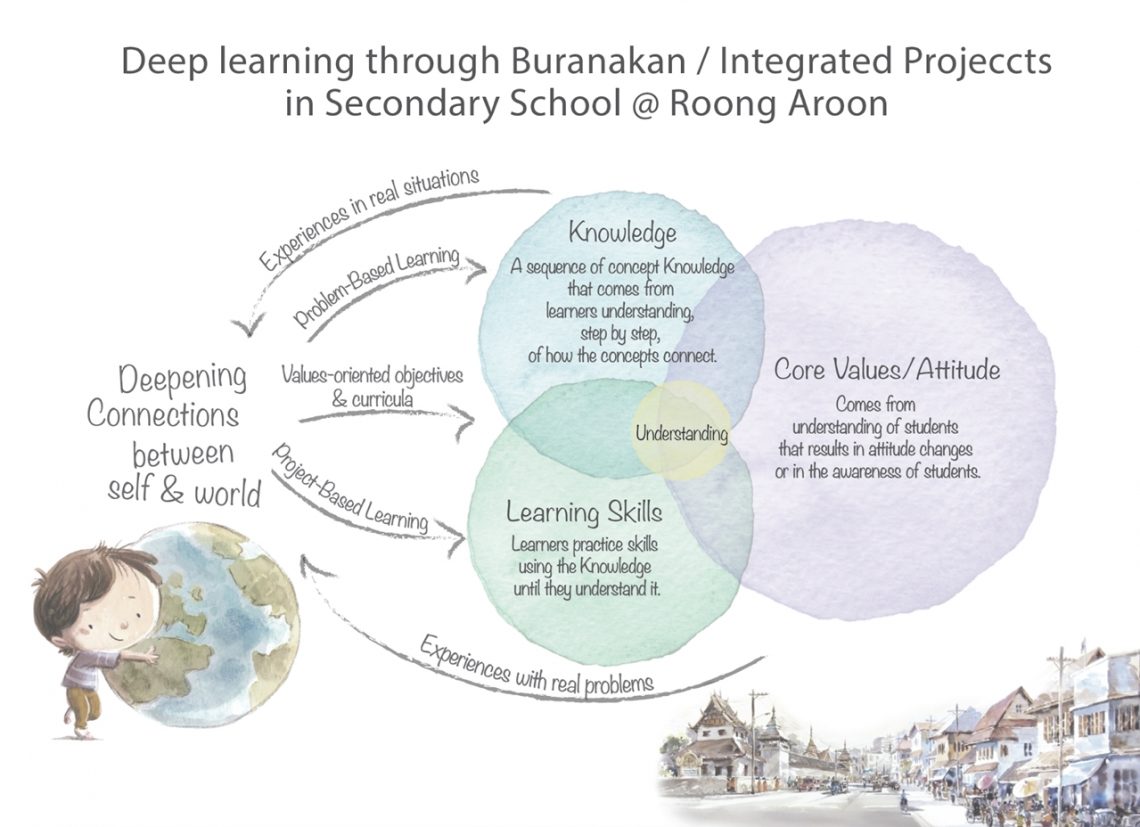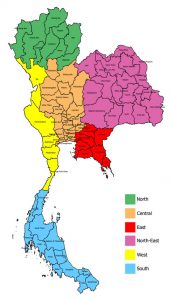
Buranakan in Grade 9: Deep Learning through Integrated Project Work
Buranakan Content Connects Students with Local Issues
Buranakan begins with explorations in new knowledge that lead to deeper inquiries, starting from where the students are and expanding outward. From this basic framework, they identify ecological/human problems to explore together.
RAS Middle Years Buranakan Curricular Framework
|
Grade 7 |
Study Bangkok, the hometown where they live. |
|
Grade 8 |
Examine issues facing central Thailand. |
|
Grade 9 |
Discover the geographical regions of Thailand in the North, Northeast, and South. |
 Later, in upper secondary school, the Buranakan framework broadens outward to examine issue-based themes and sometimes to examine good ecological practices in other countries such as Singapore.
Later, in upper secondary school, the Buranakan framework broadens outward to examine issue-based themes and sometimes to examine good ecological practices in other countries such as Singapore.
RAS Upper Years Buranakan Framework
|
Grade 10 |
Issues-focused, varies according to: ● Students’ interests ● Funding/grant sources ● Community connections |
|
Grade 11 |
|
|
Grade 12 |
Buranakan courses are adapted to reflect current events or socio-ecological issues such as creating safe food production or addressing air pollution. Each year, the teachers are encouraged to rethink its curriculum for Buranakan. For example, in 2019-2020, Grade 7 students studied plastic waste problems in Bangkok. Grade 8 studied food chains, farming, and food production for feeding the people of central Thailand, and Grade 9 examined the more remote water systems of the farther out provinces whose rivers feed into the water used in Bangkok.
Teachers’ Responsibilities
The teachers’ responsibility in relationship with students is to encourage healthy mindsets, by their ways of exchanging comments and reflections. For example if a student gets stuck in one way of thinking, Cru Pu says:
Students can express themselves in any ways they want but we listen, and then we try to say something to make them think in another way. Or ask them why they don’t think like that, or they do think like that, to make them understand themselves more.
Teachers guide students to acquire community-based experiences that link back to their ongoing questioning and new inquiries, as they refine their values, alongside acquiring new knowledge and skills. This requires detailed and holistic planning along with flexibility on the part of each Buranakan teacher, an expanding knowledge of the content that students will be learning about, and the capacity to listen carefully to where students currently are while being aware of the directions in which to guide them next. Teachers must be aware of each student’s pathway in the acquisition of knowledge and skills, along with the value-orientation and attitudes of themselves and each student.
Blending Skills, Knowledge and Values
Within the value-oriented curricula of Roong Aroon, the Buranakan teachers design lessons around an essential value, along with knowledge and skill objectives. There is a spiraling process as one phase of learning leads into the next at every turn, so that teachers must plan while remaining flexible in what students may learn along the way and new directions they choose to follow.
According to the Secondary School Principal Prempreeti Harntanong (known by her nickname of Cru Pu), Roong Aroon’s approach to Buranakan revolves around teachers inquiring, over and again, into the values that they aim for students to develop. She explains how Buranakan guides students to look at the importance of solving difficult problems by going more deeply into the content:
In Buranakan, when we see into the contents, we try to understand it through all content. … We have to help the students to reach the value of the thing that they learn: How it’s meaningful to their life and what is the fact or truth of the society that the students need to know because they are members of the society? And how do they contribute to that issue?
Cru Pu continues by explaining how value-oriented lessons help students:
to get close to the truth of life, or the truth of change, or the truth of the thing that’s running around us, the truth, not just fantasize about that. And it’s about goodness, the way that we find good inside people…
Teachers are encouraged “to integrate the value oriented learning process into every learning activity so that the learners could achieve their inner development simultaneously and continuously” (Niyom, 2018, p. 9).
Sometimes the core value, and its goodness, may be expressed in relation to knowledge or in relation with an appreciation of aesthetics as shown in skills and doing things for others, such as when a Grade 9 student suddenly gives useful, helpful feedback to another about the quality of a PowerPoint presentation. They have just learned and understood something deeply from the teacher, then they pass it on to another student who is still coming to grasp a certain aspect of slide design, and how to share knowledge of aesthetics with patience and care about what is being communicated to a friend.
The what, the how, and the reasons for learning are all blended together. Values are not completely separate from content or skills, they embody positive attitudes about a topic. They are not easy to uncover right away or to put into words by either the teachers or the students. In Roong Aroon’s values-oriented curricula, teachers must keep looking as they design their plans and lessons together with grade-level colleagues, as they guide their students too, in relationship to where/how the other is currently thinking or acting. To state that one has a value but to not act on it would be incorrect, unreal.
According to school director Sunisa Chuencharoensook (nickname Cru Mo), when training new teachers in other schools about Buranakan, the value aspect of lesson plans and roadmaps is what many teachers miss. Perhaps they think that they get it, they think that it’s easier than it really is, and that overconfidence causes them to not look as deeply as they should.

